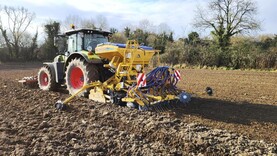Sowing: This weekend will no doubt see a hive of activity in tillage fields.
Many have been delaying sowing and waiting as patiently as they can as good weather prevails, but that patience is now running thin.
Later sowing has many benefits, from reducing disease and virus pressure to reducing grassweed incidence.
However, there’s a fine line between delaying sowing and watching the rain arrive and after the difficult autumn sowing season of 2020, it would be hard to blame anyone for heading to the fields at this stage.
Check on thousand grain weight ahead of planting to ensure the correct seed rate.
The important thing is to spread risk.
Rye can be planted first and can continue to be planted until the middle of October. BYDV is a big risk with winter barley, so if you have KWS Joyau, which claims to be a BYDV-tolerant barley, it may help to reduce BYDV risk for planting in September.
If you do not have seed ordered yet, get your order in as soon as possible, as there will no doubt be demand with the dry weather at present. There are reports of winter wheat being planted in some parts at present, but septoria is a massive risk to yield and all cultural control methods – including delayed sowing – are needed to reduce septoria levels as the chemical toolbox becomes depleted. Take-all risk is also decreased with a delay in sowing.
Grass: Where sterile brome and blackgrass are a problem, avoid sowing winter barley. Delaying winter wheat planting into October will work well with some of the germination period for these weeds.
Making the most of the good weather includes grass weed control. This year is shaping up to a good one for applying pre-emergence herbicides, which offer the best control of problem grass weeds, like meadow grass and brome, once the crop is sown. Using stale seedbeds and later sowing dates can help to decrease grass weed pressure. Another input with a price increase is glyphosate due to shortages and logistics, so it may be worth shopping around for the best prices.
Fertiliser: Autumn is a time when tillage farmers often avail of a drop in fertiliser prices to spread spend across the year. However, this autumn, prices seem out of reach. Where they will go is unclear, but as fertiliser suppliers in Ireland hold off on making purchases, diving into that market will need a lot of consideration.
One thing that can be done to be as efficient as possible with fertiliser is to soil test. Autumn is an ideal time for this job. Consider taking soil samples where they are due before sowing winter crops so they are not forgotten.
Apply for the soil sampling programme: The new soil sampling programme from the Department of Agriculture opens for applications on Monday 27 September. Farmers can get up to 16 samples through the scheme, but there is sure to be high demand so apply early. The scheme tests for major and micronutrients, as well as soil carbon.






 This is a subscriber-only article
This is a subscriber-only article










SHARING OPTIONS: